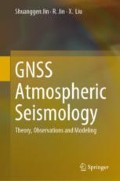Abstract
The erupting volcano will eject a large amount of rock mass, volcanic ash, volcanic gas, and other substances, which can seriously affect the integrity of buildings, damage the safety of land or air traffic, endanger the growth of plants, and affect the healthy life and safety of human beings. Therefore, it is important to monitor and forecast volcanic ash. A variety of ground or air sensors are used to monitor volcanic eruptions around the world.
Access this chapter
Tax calculation will be finalised at checkout
Purchases are for personal use only
Change history
09 October 2019
In the original version of the book, the following belated corrections are to be incorporated.
References
Aranzulla, M., Cannavo, F., Scollo, S., et al. (2013). Volcanic ash detection by GPS signal. GPS Solutions, 17(4), 485–497.
Fee, D., Steffke, A., & Garces, M. (2010). Characterization of the 2008 Kasatochi and Okmok eruptions using remote infrasound arrays. Journal of Geophysical Research Atmospheres, 115(D2).
Fournier, N., & Jolly, A. D. (2014). Detecting complex eruption sequence and directionality from high-rate geodetic observations: The August 6, 2012 Te Maari eruption, Tongariro, New Zealand. Journal of Volcanology and Geothermal Research, 286, 387–396.
Gouhier, M., Harris, A., Calvari, S., et al. (2012). Erratum to: Lava discharge during Etna’s January 2011 fire fountain tracked using MSG-SEVIRI. Bulletin of Volcanology, 74(5), 1261–1261.
Grapenthin, R., Freymueller, J. T., & Kaufman, A. M. (2013). Geodetic observations during the 2009 eruption of Redoubt Volcano, Alaska. Journal of Volcanology and Geothermal Research, 259(6), 115–132.
Houlie, N., Briole, P., Nercessian, A., et al. (2005). Sounding the plume of the 18 August 2000 eruption of Miyakejima volcano (Japan) using GPS. Nature, 414(5), 583–583.
Jin, S. G., & Komjathy, A. (2010). GNSS reflectometry and remote sensing: New objectives and results. Advances in Space Research, 46(2), 111–117. https://doi.org/10.1016/j.asr.2010.01.014.
Jin, S. G., & Najibi, N. (2014). Sensing snow height and surface temperature variations in Greenland from GPS reflected signals. Advances in Space Research, 53(11), 1623–1633.
Jin, S. G., Cardellach, E., & Xie, F. (2014). GNSS remote sensing: Theory, methods and applications (pp. 276). Springer, Netherlands, ISBN: 978-94-007-7481-0.
Jin, S. G., Qian, X. D., & Kutoglu, H. (2016). Snow depth variations estimated from GPS-reflectometry: A case study in Alaska from L2P SNR data. Remote Sensing, 8(1), 63.
Jin, S. G., Qian, X. D., & Wu, X. (2017). Sea level change from BeiDou navigation satellite system-reflectometry (BDS-R): First results and evaluation, global planet. Change, 149, 20–25. https://doi.org/10.1016/j.gloplacha.2016.12.010.
Jin, S. G., Feng, G. P., & Gleason, S. (2011). Remote sensing using GNSS signals: Current status and future directions. Advances in Space Research, 47(10), 1645–1653. https://doi.org/10.1016/j.asr.2011.01.036.
Larson, K. M., Braun, J. J., Small, E. E., et al. (2010). GPS multipath and its relation to near-surface soil moisture content. IEEE Journal of Selected Topics in Applied Earth Observations & Remote Sensing, 3(1), 91–99.
Larson, K. M. (2013). A new way to detect volcanic plumes. Geophysical Research Letters, 40(11), 2657–2660.
Ohta, Y., & Iguchi, M. (2015). Advective diffusion of volcanic plume captured by dense GNSS network around Sakurajima volcano: A case study of the vulcanian eruption on July 24, 2012. Earth, Planets and Space, 67(1), 157.
Scollo, S., Prestifilippo, M., Spata, G., et al. (2009). Monitoring and forecasting Etna volcanic plumes. Natural Hazards & Earth System Sciences, 9(5), 11993.
Scollo, S., Prestifilippo, M., Pecora, E., et al. (2014). Height estimation of the 2011–2013 Etna lava fountains. Annals of geophysics = Annali di geofisica, 57(2), 1–25.
Zhang, Q. Y. (2018). Detection of volcano plume using GNSS signal-to-noise ratio (SNR) and radio occultation data, Master Thesis, Shanghai University.
Author information
Authors and Affiliations
Corresponding author
Rights and permissions
Copyright information
© 2019 Springer Nature Singapore Pte Ltd.
About this chapter
Cite this chapter
Jin, S., Jin, R., Liu, X. (2019). Volcanic Plumes Detection from GNSS SNR. In: GNSS Atmospheric Seismology. Springer, Singapore. https://doi.org/10.1007/978-981-10-3178-6_14
Download citation
DOI: https://doi.org/10.1007/978-981-10-3178-6_14
Published:
Publisher Name: Springer, Singapore
Print ISBN: 978-981-10-3176-2
Online ISBN: 978-981-10-3178-6
eBook Packages: Earth and Environmental ScienceEarth and Environmental Science (R0)

